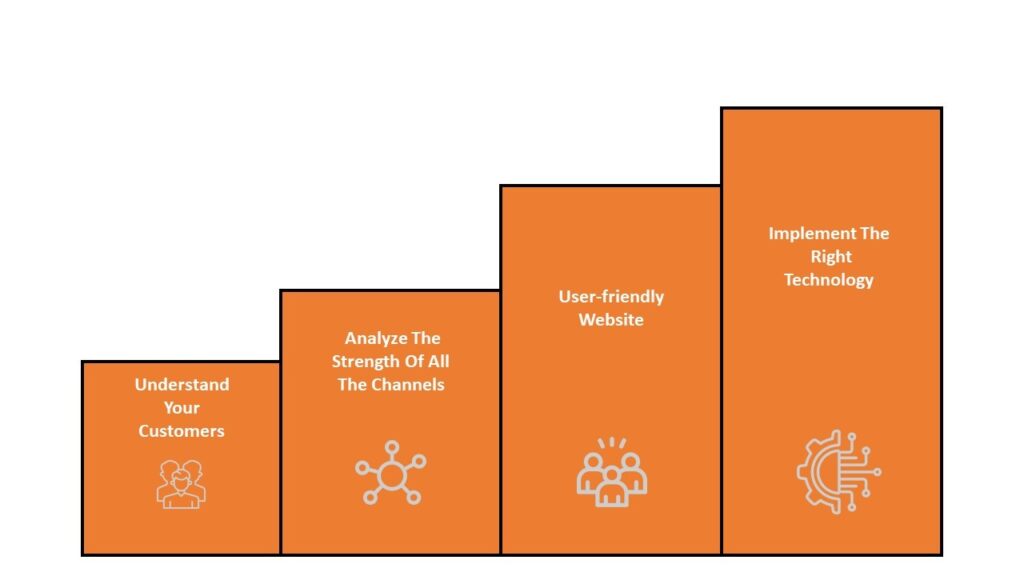With the evolution of new strategies in today’s marketing world, customers expect consistent service across all the touchpoints. Unfortunately, reaching customers through all channels is easier said than done. According to Gartner, over 90% of marketers struggle to connect seamlessly with more than three channels on the buyer journey.
There’s a solution to overcome this struggle, and that is Omni-channel Marketing. This article discusses the strategies and trends required for the future of omnichannel marketing.
WHAT IS OMNI-CHANNEL MARKETING?

Omnichannel marketing integrates various organization channels to interact with consumers and to create a consistent brand experience. Regardless of how customers interact with your brand, it provides flexibility and a seamless user experience. In this way, customers can interact with brands on their terms, which leads to an overall improved consumer experience. This enables you to connect with your customers through a personalized experience.
BENEFITS OF OMNICHANNEL MARKETING
Most brands agree that an omnichannel approach is the most effective way to reach their target audience. One can reap the following benefits by implementing omnichannel marketing:
1. User Experience
Customers are encouraged to interact with a brand across multiple touchpoints and channels while using an omnichannel strategy.
2. Brand Identity
Creating a consistent brand experience across all the platforms helps you strengthen your brand and quickly build a positive image.
3. Increase in revenue
A successful omnichannel marketing strategy relies on accurate segmentation and personalization—increased customer engagement results in more conversions and a higher ROI.
HOW TO CREATE AN EFFECTIVE OMNI-CHANNEL STRATEGY
There are four steps to create an effective Omni-Channel strategy that satisfies your customers at all touchpoints.

Understand Your Customers
Understanding your customers is the first step in developing an effective omnichannel strategy. You need to understand the demographic details of your customers, such as their location, age group, interests, etc., and most importantly, the mode of channels they use to access your content.
Analyze The Strength Of All The Channels
When you understand your customers and their goals, it becomes easier to identify the sales channels. For an omnichannel experience, you must understand each channel’s requirements and the processes required to interact with each channel and then combine them.
The Netsertive report shows that the channels are crucial for the success of an omnichannel marketing

User-Friendly Website
You should optimize your website for all platforms, including mobile phones. E-commerce statistics show that 79% of smartphone users completed an online purchase in the last six months. Web pages, particularly post-click landing pages, should contain a responsive design. This makes visitors provide their personal information.
Implement The Right Technology
When you implement the right technology, it allows you to develop personalised content and increase sales. With its ability to connect to several channels, it improves your brand’s operations and strategies.
TRENDS IN OMNI-CHANNEL MARKETING
According to Harvard Business Review, 73% of shoppers use more than one shopping channel, and these customers have a 30% higher lifetime value than those who only use one channel. To successfully implement an omnichannel strategy, the following are the trends you should consider in your business. These trends will not only help you to experience 10X growth but become a roadmap to the future of omnichannel marketing.
Automation
As new technologies emerge and user behaviour changes, outdated software will not help. Improving automation processes and sources are the best technique for omnichannel campaigns. Companies can use automated warehouses to manage online, app-based, and brick-and-mortar orders. They can also list data, track order fulfilment, sync inventories, and manage warehouses across multiple channels.
Integration with WMS
The gradual shift of a traditional warehouse to an omnichannel warehouse necessitates a thorough analysis of current processes. It also provides a detailed roadmap of the transformation. Simultaneously, one can improve the company’s visibility in terms of operations and reconfigure them to meet the needs of an omnichannel warehouse. It also offers one-touch integration across multiple sales channels and stakeholders, including delivery service providers, distributors, and suppliers.
Following are some of the reasons why WMS integration is considered an omnichannel success.
- Updates on order status
- Major online marketplaces are integrated with WMS
- Visibility of incoming orders, orders in transit, product returns, and material procurement
Improvements in Supply chain
To keep up with the growth in e-commerce sales, organisations will need to strengthen their supply chain management, inventory management, and delivery methods. These improvements are crucial as customers of omnichannel look for shorter delivery times. Various technologies, such as end-to-end visibility platforms, inventory management tools, and delivery management software, are used to meet these requirements.
Creating a smooth shopping experience for your customers at all channels such as a brick-and-mortar store, online, a smartphone, or other channels is imperative.
The future of Omnichannel marketing requires warehouse fulfilment to process the varying nature of orders received from different channels. Pyrops WMS provides excellent tracking capabilities to ensure that orders are processed as efficiently as possible. With Pyrops’ multi-channel fulfilment capabilities, you can seamlessly serve both B2B and B2C store demand.

